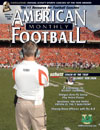AMERICAN FOOTBALL MONTHLY THE #1 RESOURCE FOR FOOTBALL COACHES
Article CategoriesAFM Magazine
|
AFM Subscribers Ask...with Troy Calhoun© More from this issueUnder first year coach Troy Calhoun, the Air Force Academy finished the 2007 regular season with a 9-3 record. The Falcons had a five-game turnaround from 2006 (4-8) and it was the second largest in nearly fifty years. Air Force had entered 2007 coming off three straight losing seasons. Calhoun was hired from the Houston Texans where he was their Offensive Coordinator. A 1989 AFA graduate, Calhoun led the Falcons to the most wins ever by a first year head coach. After his military commitment, Calhoun began his coaching career at the Academy and then coached at Ohio University, Wake Forest, and then the Denver Broncos (2003-2005). He went to the Texans for the 2006 season. Calhoun was named Mountain West Conference Coach of the Year for 2007. He continued the famous option offense that Fisher DeBerry preached for 23 y....The full article can only be seen by subscribers. Subscribe today!
|
|
|||||||
| HOME |
MAGAZINE |
SUBSCRIBE | ONLINE COLUMNISTS | COACHING VIDEOS |
Copyright 2025, AmericanFootballMonthly.com
All Rights Reserved





